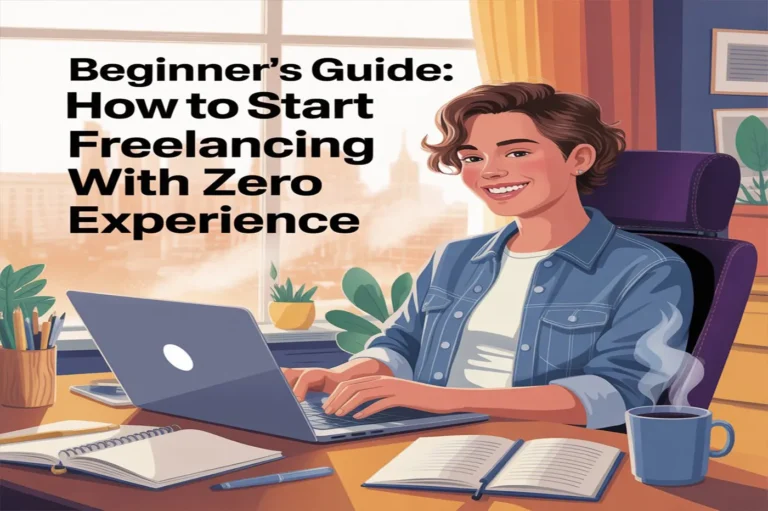In freelancing, clients don’t hire based on degrees, they hire based on proof of value. That’s exactly what your freelance portfolio provides.
Whether you are a writer, designer, developer, marketer, or virtual assistant, your portfolio is your digital storefront and in 2025’s competitive freelance market, it needs to do more than just showcase your skills. It needs to build trust, convert leads, and close deals.
This guide will walk you through exactly how to build a freelance portfolio from scratch (even with zero paid clients), what to include, where to host it, and how to position it to win better clients, faster.
Your freelance portfolio isn’t a one-time task, it’s a living asset that grows with your skills and helps you scale your career.
Treat it as your digital reputation. Keep it updated, focused, and tailored to the clients you want to attract.
Clients don’t want the cheapest. They want the clearest, most confident, and most credible choice. Your portfolio is what makes you that choice.
Why a Portfolio Is Critical in Freelancing
In traditional jobs, you rely on resumes and interviews.
In freelancing, your portfolio is the interview.
A great portfolio helps you:
- Show, not just tell your skills
- Demonstrate credibility even without formal experience
- Attract better-paying clients who value quality
- Differentiate yourself in saturated marketplaces like Upwork and Fiverr
- Increase conversion on proposals and job pitches
According to Fiverr’s 2024 report, freelancers with portfolios earn 45% more on average than those without.
What to Include in a Winning Freelance Portfolio
Regardless of your niche, here are the key elements of a standout portfolio:
Professional Introduction / Bio
- Who you are, what you do, and how you help
- Use clear, client-focused language such as: “I help e-commerce brands increase conversions through high-converting product copy.”
Portfolio Samples
- 3–7 examples of your best work
- Highlight a variety of formats if applicable (e.g. case study, article, landing page)
Project Descriptions
For each sample, include:
- Project goal or client brief
- What you specifically did
- Results (metrics, testimonials, outcomes)
Client Testimonials or Endorsements
- If you’ve worked with clients before, request testimonials
- As a new freelancer, ask for character references from mentors or previous employers
Services Offered
- Bullet list your services, be specific, example: “Email Campaign Strategy + Copywriting for SaaS Startups”
Contact Info or Inquiry Form
- Make it easy for clients to reach out
- Include email, social, or embedded Typeform/Google Form
Optional: Pricing Packages or FAQs
- This is great inclusion for beginner freelancers to reduce client hesitation
How to Build a Portfolio With No Experience
It’s 100% possible to build a great freelance portfolio from scratch.
Create Mock Projects
- Invent a brand and create deliverables as if for a real client
- Writers: Write 3 blog posts for a fake fitness brand
- Designers: Rebrand an existing logo or UI
- Developers: Build a landing page or portfolio site
Do Volunteer or Non-Profit Work
- Offer to work for NGOs, startups, or friends in exchange for a testimonial
Repurpose Past Work
- University projects, previous job tasks, or personal side projects can count
Join Portfolios Sites With Challenges
- Dribbble (designers), Behance, GitHub (devs), Medium (writers) let you build public-facing samples
Even one strong, well-described project can get you hired.
Best Platforms to Host Your Portfolio (Free & Paid)
| Platform | Best For | Free/Paid |
| Notion | Writers, VAs, general freelancers | Free |
| Wix | Visual creators, multi-section portfolios | Free/Paid |
| WordPress | Customizable blogs & portfolios | Free/Paid |
| Journo Portfolio | Writers & bloggers | Free |
| Carbonmade | Designers & artists | Paid |
| GitHub Pages | Developers | Free |
| Clippings.me | Journalists | Free |
| Behance | Designers, UX/UI | Free |
| General professionals | Free |
You don’t need a custom domain to start. Use platforms with clean URLs and upgrade later.
Portfolio Tips by Profession
Writers
- Include multiple writing styles (blogs, product copy, emails)
- Host on Medium, Notion, or personal blog
- Include reading level or SEO strategy if applicable
Designers
- Show design process, not just finished work
- Use Figma, Adobe XD, Canva mockups
- Break projects into UX goals + creative choices
Developers
- Link to live demos and GitHub repos
- Include readme files with context
- Highlight languages/tech used in each project
Virtual Assistants
- Sample inbox cleanup plan
- Screenshot of a Trello board you organized
- Testimonials from past admin roles
Common Mistakes to Avoid
- Too much content, no focus: Showcase your niche, not everything
- No context around projects: Explain the goal, not just the result
- Unclear service offering: Clients should immediately know what you do
- No call to action: Always include a contact button or form
- Outdated design: In 2025, mobile-friendly and clean layout is a must
How to Use Your Portfolio to Win Clients
On Upwork/Fiverr
- Link your portfolio in your proposals
- Customize your portfolio link per niche (e.g., landing page copy vs. blog writing)
In Cold Pitches
- Include 2–3 samples embedded or linked
- Add a testimonial or result (“helped X brand boost traffic by 30%”)
On Social Media
- Pin your portfolio on LinkedIn, Twitter
- Create a “Featured Work” highlight on Instagram
On Your Website
- Add your portfolio to your About, Services, or Work pages
- Use Google Analytics to see what projects get the most clicks
Portfolio Checklist: What You Must Have Before You Launch
- Clear, concise bio
- 3 to 5 solid work samples
- Brief context for each project
- At least 1 testimonial (or character reference)
- Contact form or call to action
- Mobile-friendly layout
- SEO-friendly file names & meta titles
- Easy-to-share URL (LinkedIn, email, social)




I’m interested to work with you. Thanks